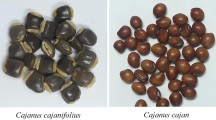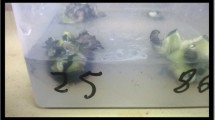Summary
The present study is an attempt to exploit somaclonal variation for the varietal improvement of pigeonpea [Cajanus cajan (L) Millsp.]. The pigeonpea plants were regenerated from cotyledon explants, and their progeny was screened for variability. The regenerated R1 plants exhibited a spectrum of alterations in floral morphology and architecture that were absent in the control population. The field-sown R2 plants segregated for traits such as flower color, leaf shape, seed size, color and strophiolation, flowering habit, and fertility. Tissue culture produced different mutational events resulting in both dominant and recessive alleles. Significant variation was observed for plant height, seed mass, and damage due to the insect pest Helicoverpa armigera. The R3 plants, obtained from seed of R2 generation selected for traits such as white seed coat, strophiolation, reduced plant height, seed mass and low damage due to Helicoverpa, maintained the traits when compared with the seed-derived control populations. The results indicate a definite gene for white seed coat and the possibility of additional genes for pest tolerance and high seed mass in an adapted background.
Similar content being viewed by others
References
Barbier, M.; Dulieu, H. Early occurrence of genetic variants in protoplast cultures. Plant Sci. Lett. 29:201–206; 1983.
Barwale, U. B.; Widholm, J. M. Somaclonal variation in plants regenerated from cultures of soybean. Plant Cell Rep. 6:365–368; 1987.
Barwale, U. B.; Widholm, J. M. Soybean: plant regeneration and somaclonal variation. In: Bajaj, Y. P. S., ed. Biotechnology in agriculture and forestry. Vol. 10. Legumes and oilseed crops I. Berlin, Germany: Springer-Verlag; 1990.
Bhaskaran, S.; Smith, R. H.; Paliwal, S., et al. Somaclonal variation from Sorghum bicolor (L.) Moench cell culture. Plant Cell Tissue Organ Cult. 9:189–196; 1987.
Bhatia C. R.; Mathews, H. Inheritance of the somaclonal variation in Mung bean (Vigna radiata (L.) Wikzek. J. Hered. 79(2):122–124; 1988.
Cheng, M.; Hsi, D. C. H.; Phillips, G. C. In vitro regeneration of valenciatype peanut (Arachis hypogeae L.) from cultured petiolules, epicotyl sections and other seedling explants. Peanut Sci. 19:82–87; 1992.
Dahleen, L. S.; Stuthman, D. D.; Rines, H. W. Agronomic trait variation in oat lines derived from tissue culture. Crop Sci. 31:90–94; 1991.
Evans, N. E.; Foulger, D.; Farrer, L., et al. Somaclonal variation in explant derived potato clones over three tuber generations. Euphytica 35:353–361; 1986.
Gengenbach, B. G.; Green, C. E.; Donovan, C. M. Inheritance of selected pathotoxin resistance in maize plants regenerated from cell cultures. Proc. Natl. Acad. Sci. USA 74:5113–5117; 1977.
GENSTAT. A general statistical programme reference manual; Statistical department, Rothamsted Experimental Station; Published by Numerical Algorithm Group Ltd., UK; Oxford, U.K.: Clarendon Press; 1987.
Greybosch, R. A.; Edge, M. E.; Delanny, X. Somaclonal variation in soybean plants regenerated from cotyledonary node system. Crop Sci. 27:803–806; 1987.
Groose, R. W.; Bingham, E. T. An unstable anthocyanin mutation recovered from tissue culture of alfalfa (Medicago sativa) 1. High frequency of reversion upon reculture. Plant Cell Rep. 5:104–107; 1986.
Hartman, C. L.; McCoy, T. J.; Knous, T. R. Selection of alfalfa (Medicago sativa) cell lines and regeneration of plants resistant to the toxin(s) produced by Fusarium oxysporium f. sp. medicaginis. Plant Sci. Lett. 43:183–194; 1984.
Heath-Pagliuso, S.; Pullman, J.; Rappaport, L. Somaclonal variation in celery: screening for resistance to Fusarium oxysporium f. sp. apii. Theor. Appl. Genet. 75:446–451; 1988.
Isenhour, D. J.; Duncan, R. R.; Miller, D. R., et al. Resistance to leaf-feeding by the fall armyworm (Lepidoptera: Noctuidae) in tissue culture derived sorghums. J. Econ. Entomol. 84(2):680–684; 1991.
Krishnamurthi, M.; Tlaskal, J. Fiji disease resistant Saccharum officinarum var. Pindar subclones from tissue cultures. Proc. Int. Soc. Sugar Cane Technol. 15:130–137; 1974.
Larkin, P. J.; Banks, P. M.; Bhati, R., et al. From somatic variation to variant plants: mechanisms and applications. Genome 31:705–711; 1989.
Larkin, P. J.; Ryan, S. A.; Brettel, R. K., et al. Heritable somaclonal variation in wheat. Theor. Appl. Genet. 67:443–455; 1984.
Lee, M.; Phillips, R. L. Genetic variants in progeny of regenerated maize plants. Genome 29:834–838; 1987.
Lourens, A. G.; Martin, F. A. Evaluation of in vitro propagated sugarcane hybrids for somaclonal variation. Crop Sci. 27:793–796; 1987.
Mallikarjuna, N.; Moss, J. P. Production of hybrids between Cajanus platycarpus and Cajanus cajan. Euphytica 83(1):43–46; 1995
Mathews, V. H. M.; Rao, P. S.; Bhatia, C. R. Somaclonal variation in cotyledonary plants of mung bean. Z. Pflanzenzuech. 96:169–173; 1986.
Niizeki, M.; Ishikawa, R.; Saito, K. Variation in a single protoplast- and seedderived population of Lotus corniculatus L. Theor. Appl. Genet. 80:732–736; 1990.
Phillips, G. C.; Collins, G. B. In vitro tissue culture of selected legumes and plant regeneration from callus cultures of red clover. Crop Sci. 19:59–64; 1979.
Ranch, J. P.; Palmer, R. G. A ploidy variant regenerated from embryogenic tissue cultures of soybean. Soyb. Genet. Newslett. 14:161–163; 1987.
Reddy, L. J. In: Pigeonpea breeding. ICRISAT, Pulse breeding progress report 3, Patancheru, A.P., India; 1979.
Ryan, S. A.; Larkin, P. J.; Ellison, F. W. Somaclonal variation in some agronomic and quality characters in wheat. Theor. Appl. Genet. 74:77–82; 1987.
SAS Institute. SAS user’s guide: Statistics. Cary, NC: SAS Institute; 1985.
Shahin, E. A.; Spivey, R. A single dominant gene for Fusarium wilt resistance in protoplast-derived tomato plants. Theor. Appl. Genet. 73:164–169; 1986.
Shepard, S. L. K.; Sohndhal, M. K. Selection for early blight disease resistance in tomato: use of tissue culture with Alternaria solani culture filtrate. Sixth International Congress Plant Tissue and Cell Culture. Abstract, University of Minnesota, Minneapolis. p. 211; 1986.
Zehr, B. E.; Williams, M. E.; Duncan, D. R., et al. Somaclonal variation in the progency of plants regenerated from callus cultures of seven inbred lines of maize. Can. J. Bot. 65:491–499; 1987.
Author information
Authors and Affiliations
Additional information
Submitted as Journal Article No. 1906 by International Crops Research Institute for the Semi-Arid Tropics (ICRISAT).
Rights and permissions
About this article
Cite this article
Chintapalli, P.L., Moss, J.P., Sharma, K.K. et al. In vitro culture provides additional variation for pigeonpea. In Vitro Cell.Dev.Biol.-Plant 33, 30–37 (1997). https://doi.org/10.1007/s11627-997-0037-3
Received:
Accepted:
Issue Date:
DOI: https://doi.org/10.1007/s11627-997-0037-3




